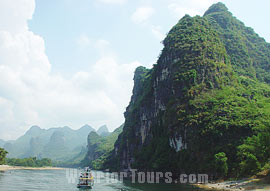- Elephant Trunk Hill & Ling Canal
- Fubo Hill & Diecai Hill
- Li River Scenery
- Longsheng & Sanjiang
- Reed Flute Cave & Seven-star Park
- Solitary Beauty Peak & Tombs of Prince Jingjiang
- Yangshuo
Solitary Beauty Peak & Tombs of Prince Jingjiang

![]() Solitary Beauty Peak
Solitary Beauty Peak
Located inside the remains of the ancient imperial city of Prince Jingjiang, an imperial family of the Ming Dynasty (1368 - 1644), the precipitous Solitary Beauty Peak rises abruptly above the ground on the western bank of Li River in the city center. A poem from the Southern Dynasties goes like that 'No others can compete with the solitary beauty of this peak.', hence the name.
On top of the peak there is a two-storied traditional Chinese pavilion with the same name, serving as both a decorative structure and observation post in the past. On the huge extruding cliff rock in front of the pavilion, a ten-square-meter (107-square-feet) flat with stone enclosures allows tourists to have a panoramic view of the surrounding scenery.
At the foot of the hill is the site of the imperial mansions of Prince Jingjiang (the old name of Guilin) in the Ming Dynasty. The construction of the mansions began from 1372 and was completed 20 years later. Originally enclosed by a 1,500-meter-long (4,920 feet) city wall, the imperial complex were composed of a full range of mansion gates, main palace halls, ancestral temples and other residential garden buildings. It had served as the mansion of 14 Princes of Jingjiang before being destroyed by fire in a peasant uprising during the later Qing Dynasty (1644 - 1911). The present remains include only the old mansion gate, some palace foundations and balusters.
At the western foot of the hill, there is a 30-meter long (98 feet) cave in which a coin inscribed with 'Taiping Tongbao' from the Song period between the year of 976 and 997 was found. Groups of rock formations and grotesque stalactites hanging from the cave ceiling create a spectacular scene. On the cliff wall are numerous poem inscriptions from the Ming period.
|
Admission Fee:
|
CNY 15 for Jingjiang City, this site included.
|
|
Opening Hours:
|
08:00 to 17:50
|
|
Recommended Time for a Visit:
|
Half an hour
|
![]() Tombs of Prince Jingjiang
Tombs of Prince Jingjiang
Jingjiang was the old name of Guilin during the Ming Dynasty (1368 - 1644) and Prince Jingjiang was entitled to Zhu Shouqian, nephew of Ming Emperor Zhu Yuanzhang, who was sent to administrate this area. Later the title has being kept for the successively 13 lords alike.
At the southwestern foot of Rao Mountain, there are a range of imperial tombs of 11 of the 14 Ming Princes. Surrounded by lofty mountains, the tombs are reputed as the best-preserved seignior tombs in China.
The tombs are constructed in a typical Chinese mausoleum layout, and each of them has its own tomb gate, the sacred way flanked with stone carved officials and animals in pairs, the main constructions of palace halls and underground palaces arranged in line on an axis.
The present tomb opened to the public is a joint-tomb of Prince Zhuangjian and his wife. An exhibition of relics excavated from the underground tomb is on display in the main palace hall of the tomb, among which an exquisite blue porcelain vase with plum blossoms are very precious.
Admission Fee: CNY 15

